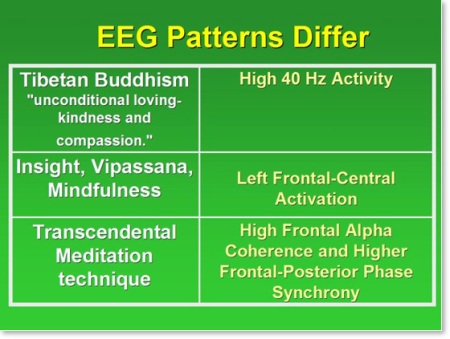Are all meditation techniques the same?
Reproduced from the Transcendental Meditation Blog
by Ken Chawkin on September 22, 2010
As doctors increasingly prescribe meditations to patients for stress-related disorders, scientists are gaining a better understanding of how different techniques from a wide of traditions, both modern and ancient, produce different results.
A new paper published this past summer in Consciousness and Cognition discusses three categories to organize and better understand meditation:
1. Focused attention—concentrating on an object, idea, or emotion;
2. Open monitoring—being mindful of one’s breath, thoughts or feelings;
3. Automatic self-transcending—meditations that transcend their own activity
Each category was assigned EEG bands, based on reported brain patterns during mental tasks, and meditations were categorized based on their reported EEG.
”The idea is that meditation is, in a sense, a ‘cognitive task,’ and EEG frequencies are known for different tasks,” said Fred Travis, Ph.D., co-author, and Director of the Center for Brain, Consciousness, and Cognition at Maharishi University of Management.
Focused attention, characterized by beta/gamma activity, included meditations from Tibetan Buddhist (loving kindness and compassion), Buddhist (Zen and Diamond Way), and Chinese (Qigong) traditions.
Open monitoring, characterized by theta activity, included meditations from Buddhist (Mindfulness, and ZaZen), Chinese (Qigong), and Vedic (Sahaja Yoga) traditions.
Automatic self-transcending, characterized by alpha1 activity, included meditations from Vedic (Transcendental Meditation) and Chinese (Qigong) traditions.
Between categories, the included meditations differed in focus, subject/object relation, and procedures. These findings shed light on the common mistake of averaging meditations together to determine mechanisms or clinical effects.
 ”Meditations differ in both their ingredients and their effects, just as medicines do. Lumping them all together as ‘essentially the same’ is simply a mistake,” said Jonathan Shear, Ph.D., co-author, professor of philosophy at Virginia Commonwealth University in Richmond. Dr. Shear is also the author of several books on meditation, including the well-known book, The Experience of Meditation which presents an introduction to the major meditation traditions of the world.
”Meditations differ in both their ingredients and their effects, just as medicines do. Lumping them all together as ‘essentially the same’ is simply a mistake,” said Jonathan Shear, Ph.D., co-author, professor of philosophy at Virginia Commonwealth University in Richmond. Dr. Shear is also the author of several books on meditation, including the well-known book, The Experience of Meditation which presents an introduction to the major meditation traditions of the world.
”Explicit differences between meditation techniques need to be respected when researching physiological patterns or clinical outcomes of meditation practices,” said Dr. Travis. ”If they are averaged together, then the resulting phenomenological, physiological, and clinical profiles cannot be meaningfully interpreted.”
Web references:
Talk by Dr. Travis, “Are all meditations the same?”
Transcendental Meditation Brain Research
Read more, including Comments
Related posts: Tagged as: Research
New studies show reduced depression with Transcendental Meditation
Also see: and THP: How Meditation Techniques Compare and Are all meditation techniques the same?
See infographic and video on three categories of meditation.


February 19, 2012 at 12:24 pm |
[…] see Meditation Techniques Have Different Effects | THP: How Meditation Techniques Compare | Are all meditation techniques the same?. Share this:TwitterFacebookEmailMoreStumbleUponDiggRedditPrintLike this:LikeBe the first to like […]
LikeLike
May 31, 2012 at 4:31 pm |
[…] posts: Words—a poem on the nature of words and mind | Are all meditation techniques the same? | John Hagelin — “Only Higher Consciousness Can Transform Our World” — Beyond […]
LikeLike
September 11, 2012 at 12:47 pm |
[…] former NIMH researcher explained three different categories of meditation and how they effect the brain. He said having the right instruction in meditation can make a world […]
LikeLike
October 22, 2012 at 12:54 am |
[…] Meditation differs from some other forms of meditation in that it allows the mind to effortlessly “transcend […]
LikeLike
February 3, 2013 at 3:57 pm |
[…] One last point, and that is comparing different meditation practices and assigning their results to each other can be a bit misleading. With the aid of fMRI, EEG, and other methods we can now see that different parts of the brain are effected by different practices. To better understand these differences scientists have created categories of meditation and fit different approaches into these categories according to their scientific measurements. See Are all meditation techniques the same?. […]
LikeLike
April 24, 2013 at 10:07 pm |
[…] A recent paper published in Consciousness and Cognition gives a scientific explanation of different categories of meditation from major traditions, their practices, brainwave signatures and outcomes. See Are all meditation techniques the same? […]
LikeLike